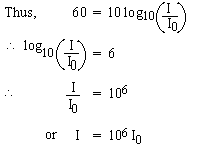|
CHAPTER 10 : SOUND WAVES The science of mechanics grows out of the human sense of touch and sight by gradually extracting information, gathered through experimentation, into abstract theoretical frame work. In the same way, the science of Sound grows out of the human sense of perception of hearing. Upon realization that these perceptions are manifestations of vibrations, the theory of sound can also be developed on the basis of principles of mechanics. These developments constitute the topic of sound, as presented in this book. The elastic (longitudinal) waves in the air to which the human ear is sensitive are called sound waves. Thus 'sound' can be described as longitudinal elastic waves in air. (In fluids only longitudinal waves can be produced because fluids cannot sustain shear deformation. However on the free surfaces of liquids, transverse waves can also be produced.) These longitudinal sound waves are produced by vibrating objects, like vocal chords, various musical instruments, etc.
10.1 Intensity and Pitch Intensity of a sound wave is defined as Power flux i.e., amount of energy incident per unit normal area per unit time; i.e., Intensity I is measured in units of 1 Watt/m2 The practical unit of Intensity is called 1 decibel (1dB) which really stands for comparison with some standard intensity (I0) on the logarithmic (base 10) scale, and is defined as
If I0 = 10-12 watt/m2, the threshold of hearing i.e. the intensity that is just audible to a normal ear then b = 60 dB for normal conversation.
Thus the intensity of sound in normal conversation is a million times greater than the just audible intensity of sound. Loudness Loudness of sound is the qualitative or subjective measure of intensity and generally corresponds to intensity. A sound of a particular intensity with different frequencies can be perceived as having different loudness by the same person; or two persons may perceive the loudness to be different even if they both listen to the sound of the same intensity . Pitch The response of the human ear to sound in terms of shrillness of sound is called pitch. This is against quantitative and subjective measure, and it corresponds to the objective measure called frequency. Thus a high pitch or shriller sounds correspond to a high frequency etc. |
10.1 Intensity and Pitch Follow @Pinkmonkey_com  |

